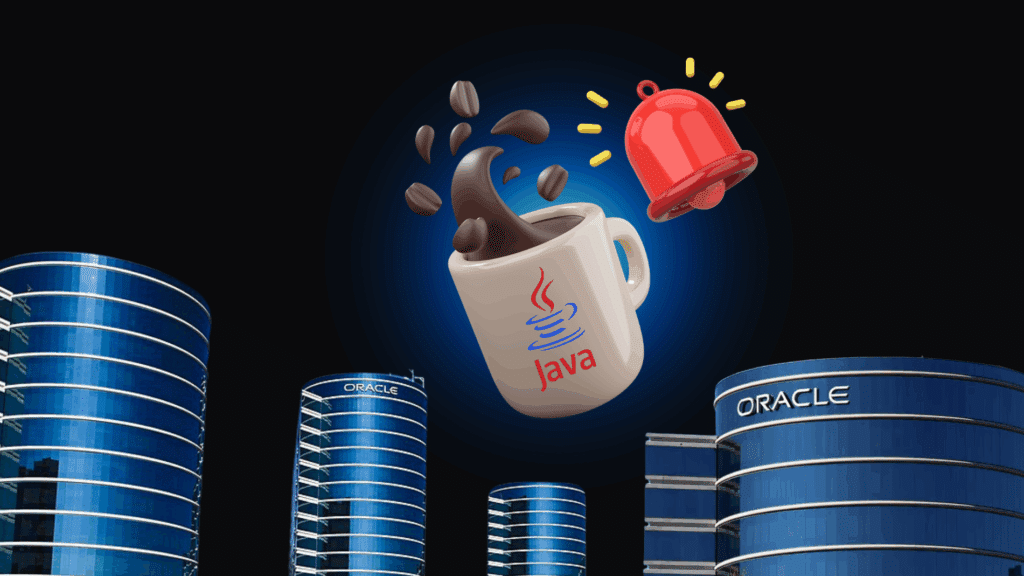Oracle Java Audits Surge: 73% of Users Targeted as Licensing Changes Drive Mass Migration to Open Source

A startling new survey has revealed the extent of Oracle’s aggressive audit campaign targeting Java users, with nearly three out of four organizations reporting they have been audited within the past three years. The findings, which paint a picture of an industry under siege from escalating compliance costs and licensing complexity, are driving an unprecedented exodus toward open-source alternatives as enterprises seek to escape Oracle’s increasingly expensive Java ecosystem.
The Audit Epidemic: A Statistical Reality
The comprehensive survey, conducted by market research firm Dimensional Research and commissioned by the ITAM Forum and Azul Systems, polled 500 IT asset managers across organizations using Oracle Java[1]. The results reveal a landscape fundamentally transformed by Oracle’s licensing strategy, with 73% of respondents confirming they had experienced Java audits in the preceding three years. This figure represents more than just statistical data, it reflects a systematic shift in how Oracle monetizes its Java platform, moving from a traditionally open development environment to an aggressive compliance enforcement model.
The frequency of these audits has reached alarming levels for many organizations. Recent reports indicate that some businesses are experiencing as many as four Oracle Java audits annually, creating a constant state of compliance anxiety that diverts resources from core business activities[2]. This audit intensity represents a dramatic escalation from historical patterns, where Oracle audits were relatively infrequent events that most organizations could expect to encounter perhaps once every several years.
The survey’s findings align with broader industry observations about Oracle’s enforcement strategy. Since implementing major licensing changes in 2023, Oracle has systematically targeted enterprises that previously operated under the assumption that Java was freely available for commercial use. The company’s audit tactics now include email-initiated informal audits, analysis of download records, and deployment of installation tracking software to identify potential compliance gaps[3].
The Financial Burden of Compliance
The economic impact of Oracle’s audit strategy extends far beyond the immediate costs of licensing fees. The survey reveals that 54% of organizations spend more than $ 100,000 annually on resolving licensing non-compliance issues, while 27% report expenditures exceeding $ 100,000 per year on resolving licensing non-compliance issues, with a total of $275,000 per year [4]. These figures represent only the direct costs of compliance management and do not account for the broader organizational disruption caused by audit processes.
The financial exposure facing organizations has grown exponentially since Oracle transitioned to the Java SE Universal Subscription model in January 2023. Under this employee-based pricing structure, organizations pay between $5.25 and $15 per employee per month, depending on company size[5]. For enterprises with thousands of employees, this pricing model can result in annual Java licensing costs reaching millions of dollars, a dramatic increase from previous per-processor or per-user models.
Perhaps most concerning for organizations is the potential retroactive liability associated with Oracle audits. Industry experts warn that Oracle could claim organizations owe up to five years of subscription fees for their entire employee base, regardless of actual Java usage patterns[6]. For a company with 10,000 employees, this could translate to a potential audit settlement exceeding $4 million, based on current list pricing structures.
The complexity of modern software environments compounds these financial risks. Twenty-five percent of survey participants reported that complex software configurations make it challenging to track application usage. At the same time, 29% of IT asset management professionals acknowledged their organizations struggle to manage licensing information effectively[7]. This challenge is particularly acute when tracking software usage across distributed teams or hybrid on-premises and cloud environments, where Java applications may be deployed without centralized oversight.
The Great Java Migration: Embracing Open Source Alternatives
The survey’s most significant finding may be the scale of migration away from Oracle’s Java platform. Nearly eight out of ten Oracle Java users reported they had either migrated or planned to shift to open-source Java alternatives, with only 14% expressing intention to remain with Oracle’s subscription model[8]. This represents one of the largest technology platform migrations in recent enterprise computing history, driven primarily by cost considerations and audit risk mitigation.
The migration trend reflects a broader industry recognition that viable alternatives to Oracle Java exist and can provide equivalent functionality without the associated licensing complexity. Popular open-source alternatives include Red Hat OpenJDK, Adoptium Eclipse Temurin, Amazon Corretto, Azul Zulu, and BellSoft Liberica[9]. These distributions offer enterprise-grade support and long-term stability while eliminating the audit risk and escalating costs associated with Oracle’s commercial Java offerings.
Industry surveys support the scale of this migration, with separate research indicating that 86% of IT professionals with Java expertise are migrating at least some portion of their applications to open-source alternatives[10]. The percentage of organizations considering alternatives to Oracle Java has jumped from 72% in 2023 to 88% in 2025, demonstrating accelerating momentum away from Oracle’s platform[11].
Oracle’s Strategic Transformation and Industry Response
Oracle’s aggressive audit strategy represents a fundamental transformation of its Java business model, moving from a platform designed to encourage widespread adoption to one focused on maximizing revenue from existing users. This shift began with the introduction of paid Java subscriptions in September 2018 and accelerated through four major licensing and pricing changes between 2020 and 2023[12].
The company’s transition to employee-based pricing in January 2023 marked a particularly significant inflection point, with Gartner recording price increases of between two and five times for organizations switching to the new licensing model[13]. Some organizations have reported cost increases of up to 700%, fundamentally altering the economics of Java deployment in enterprise environments[14].
Martin Thompson, founder of the ITAM Forum, characterized the situation as representing “a fundamental mismatch between the complexity of modern software licensing and the resources organizations rely on to effectively manage software compliance”[15]. This observation highlights a broader challenge facing enterprise IT departments, where licensing complexity has outpaced organizational capabilities to manage compliance effectively.
The Path Forward: Strategic Implications for Enterprise IT
The survey findings illuminate several critical considerations for enterprise IT leaders navigating Oracle’s transformed Java landscape. Organizations must now treat Java licensing as a strategic business decision rather than a technical implementation detail, requiring executive-level attention and dedicated compliance resources.
For organizations choosing to remain with Oracle Java, proactive compliance management has become essential. This includes implementing comprehensive Java usage tracking, conducting regular compliance assessments, and ensuring executive buy-in for compliance programs. Organizations must also prepare for the likelihood of multiple audits and budget accordingly for both compliance costs and potential settlement expenses.
However, the survey data suggests that migration to open-source alternatives represents the preferred strategy for most organizations. The availability of enterprise-grade support for OpenJDK distributions has eliminated many of the traditional barriers to open-source adoption, while the cost savings and audit risk elimination provide compelling business justification for migration projects.
The survey’s findings document a Java ecosystem in the midst of fundamental transformation. Oracle’s audit-driven licensing strategy has successfully generated significant revenue increases but at the cost of widespread customer dissatisfaction and accelerated migration to alternatives. The 73% audit rate represents more than a compliance challenge, it reflects a business model that prioritizes short-term revenue extraction over long-term platform growth and developer satisfaction.
For the broader Java community, these developments represent both challenge and opportunity. While Oracle’s licensing changes have created significant disruption for existing Java deployments, they have also accelerated innovation and investment in open-source alternatives. The mass migration documented in the survey may ultimately strengthen the Java ecosystem by reducing dependence on a single commercial vendor and fostering greater diversity in platform options.
As organizations continue to grapple with Oracle’s licensing requirements, the survey data suggests that the Java community is voting with its feet, choosing open-source alternatives that provide technical equivalence without the associated compliance burden. This trend, if it continues at current rates, may fundamentally reshape the Java landscape, returning the platform to its open-source roots while providing enterprises with the stability and support they require for mission-critical applications.
References
[1] The Register. “Nearly 3 out of 4 Oracle Java users say they’ve been audited in the past 3 years.” July 15, 2025. https://www.theregister.com/2025/07/15/oracle_java_users_audited/
[2] Computer Weekly. “Businesses say they are getting four Oracle Java audits a year.” July 14, 2025. https://www.computerweekly.com/news/366627543/Businesses-say-they-are-getting-four-Oracle-Java-audits-a-year
[3] Redress Compliance. “Oracle Java Audit Tactics – E-mails and Download Records.” July 9, 2025. https://redresscompliance.com/oracle-is-terrorizing-organizations-with-java-audits/
[4] The Register. “Nearly 3 out of 4 Oracle Java users say they’ve been audited in the past 3 years.” July 15, 2025.
[5] Oracle Licensing Experts. “ORACLE Java Licensing Costs Increase By 700%.” July 14, 2025. https://oraclelicensingexperts.com/oracle-java-licensing-costs-increase-by-700/
[6] Atonement Licensing. “Oracle Java Audit: What Every Organization Needs to Know.” March 31, 2025. https://atonementlicensing.com/oracle-java-audit-what-every-organization-needs-to-know/
[7] The Register. “Nearly 3 out of 4 Oracle Java users say they’ve been audited in the past 3 years.” July 15, 2025.
[8] Ibid.
[9] SoftwareOne. “Oracle Java alternatives: Is it worth migrating your Java applications?” August 1, 2024. https://www.softwareone.com/en-ch/blog/articles/2024/08/01/oracle-java-alternatives-app-migration
[10] DevOps.com. “Survey Surfaces Mass Open Source Java Migration.” July 25, 2024. https://devops.com/survey-surfaces-mass-open-source-java-migration/
[11] DevOps Digest. “Enterprises Consider Leaving Oracle Java as Costs and Concerns Soar.” March 12, 2025. https://www.devopsdigest.com/enterprises-consider-leaving-oracle-java-as-costs-and-concerns-soar
[12] The Register. “Nearly 3 out of 4 Oracle Java users say they’ve been audited in the past 3 years.” July 15, 2025.
[13] Ibid.
[14] Oracle Licensing Experts. “ORACLE Java Licensing Costs Increase By 700%.” July 14, 2025.
[15] The Register. “Nearly 3 out of 4 Oracle Java users say they’ve been audited in the past 3 years.” July 15, 2025.









